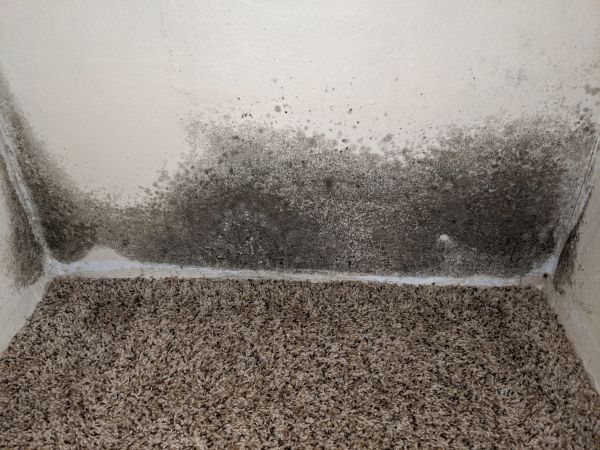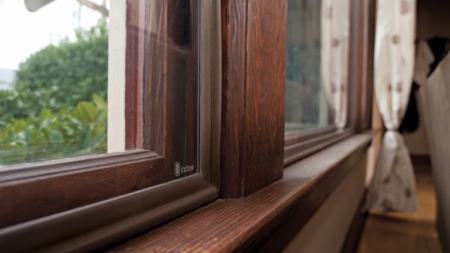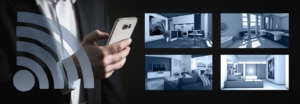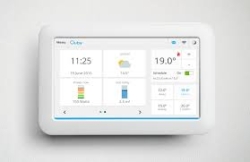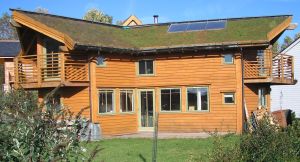Mold can become a problem any time of the year inside of buildings, but especially so during rainy weather. Indoor mold smells unpleasant and causes biodegradation (decomposition) of building materials. In addition, it may cause sick-building syndrome for building occupants.
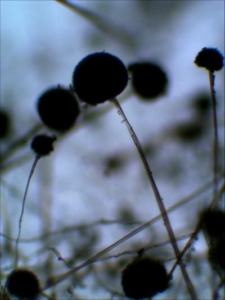
Mold spores
What exactly is mold? Mold is a fungi, neither plant nor animal, that forms and multiplies on various damp or decaying materials. Mold survives outdoors by using fallen leaves and other decaying organic matter to obtain nutrition. Indoors, mold thrive on moisture and a nutrient source like wood, cotton (clothing, blankets, curtains, etc), leather, paper (books, documents, wall art, etc). Mold spreads by releasing tiny spores that float through the air until landing in another area. New mold colonies are formed when the spores settle on damp surfaces.
There are many different species of mold that appear in different colors. Some species of mold release mycotoxins as a means to spread. Mycotoxins are carried on the mold spores and are absorbed by building occupants through respiratory airways, the skin, and even intestines. This can lead to symptoms of sick-building syndrome, such as headaches, memory problems, fatigue, coughing, throat discomfort, sinus problems, vision changes, weakness, and more.
Mold can be classified as viable or non-viable. Viable means the spores are able to reproduce. Non-viable mold has dead spores, but they are still hazardous because the cell walls can break apart and release mycotoxins. Mold thrives in damp environments. Excess moisture inside a building can come from leaky pipes, flooding, 50% or higher humidity, roof leaks, window leaks, etc. It becomes problematic when materials, such as rugs, carpets, walls, drapes, remain damp for extended periods of time.
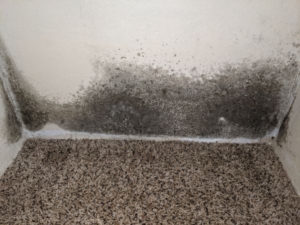
Moldy wall
Mold may be obvious to building occupants and appear on clothing stored in closets near damp walls or carpets, on the walls near a leaky window or pipe, on or behind furniture, etc. Indoor mold may be inside the walls or otherwise unnoticed by building occupants, yet still cause problematic health symptoms. Hidden mold can be caused by a water source out of view, such as excess moisture in the building foundation due to the slope of the surrounding land (see blog article about drainage systems), a leaky roof, or wet insulation within a ceiling or wall. Symptoms of sick-building syndrome can still affect building occupants when the mold is in the walls or otherwise hidden.
According to the National Institute for Occupational Safety and Health (NIOSH), the most reliable way to detect mold in a building is via visual inspection and searching for problem areas when musty odors are noticed. Results of indoor air quality reports often do not capture the full range of exposure. If unsure whether or not mold is present in a building, there are some testing methods:
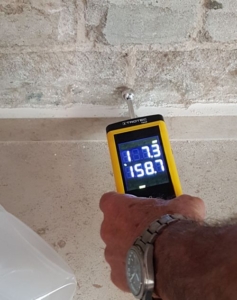
Moisture meter
- Moisture meter: If there is a musty smell or suspected moisture in the walls, a moisture meter may help with detection. A moisture meter can be purchased at a local hardware store. Place the meter’s probes in the wall to measure dampness.
- Thermal imaging device: A personal thermal imaging device, such as by FLIR ONE or Fluke, can detect moisture in walls and carpets in a non-invasive way.
- Dust testing: Samples of dust are collected with a Swiffer-type AccuCloth and tested. One test is the HERTSMI which can identify 5 species of mold. Another test called the ERMI Environmental Relative Moldiness Index) tests for 36 species of mold. These tests are available online from a few different companies, such as Mycometrics and EMSL.
- Tape sampling: Clear cellophane tape or a slide with adhesive is pressed against a moldy surface, then sent to a lab for analysis.
- Hiring a professional mold inspector: If you prefer to hire an expert, there are mold inspection companies that will perform inspections and tests to check for mold and mycotoxins.
What can be done if there is a definite mold problem? According to NIOSH, appropriate remediation with proper mold containment should be used to minimize the spread of mold spores and exposure to building occupants. Inadequate remediation, such as painting over water-damaged or moldy surfaces, can make matters worse with building degradation and sick-building syndrome symptoms.
If there is a known leak, damp areas need to be dried as soon as possible, preferably within 48 hours of water exposure, or subsequently removed. Repairs need to be made to prevent further water entry into building areas. Insufficient ventilation also contributes to the buildup of moisture. There are several helpful anti-fungal options of products to use while scrubbing mold off of hard surfaces:
- A paste made from borax and water or baking soda and water

- Hydrogen peroxide
- White vinegar
- Tea tree oil – this can be made into a spray using 1 teaspoon of tea tree oil per cup of water. Tea tree oil can also be added to other products, such as borax and vinegar, to boost their effectiveness.
- A spray bottle with vodka – Spray on the affected area, let it sit for 10+ minutes, and then scrub.
- Do NOT use bleach or ammonia. Bleach is not an antimicrobial and it emits hazardous vapors. Ammonia can help with surface mold, but it does not help with non-viable spores that mycotoxins.
- There are also spray products available for purchase, but avoid those with sodium hypochlorite (bleach) on the label.
For clothing and bedding, use the hottest possible water to wash the clothes in. Add a cup of vinegar in addition to detergent. Another option is to add half a cup of borax. Some absorbent or porous materials, such as carpet, may have to be thrown away if moldy. The US Environmental Protection Agency (EPA) advises, “if you are unsure about how to clean an item, or if the item is expensive or of sentimental value, you may wish to consult a specialist. Specialists in furniture repair, restoration, painting, art restoration and conservation, carpet and rug cleaning, water damage, and fire or water restoration” can be found by looking online or in a directory.
The EPA has a guide on proper mold remediation in homes, especially if the area is more than 10 square feet, and in commercial buildings. If a building occupant decides to hire a professional mold remediation contractor to do the clean-up, check references and make sure they follow EPA recommendations, the American Conference of Government Industrial Hygienists (ACGIH), or other professional or government organizations.
Resources:
EPA – https://www.epa.gov/mold/mold-cleanup-your-home
EPA Guide on mold remediation in larger areas – https://www.epa.gov/mold/mold-remediation-schools-and-commercial-buildings-guide
Info on drainage systems for buildings – http://www.bronzeconstruction.net/blog/exterior-drainage-systems/
American Conference of Government Industrial Hygienists – https://www.acgih.org/
Guidelines on Assessment and Remediation of Fungi in Indoor Environments (from the NYC Dept of Health and Mental Hygiene)- https://www1.nyc.gov/assets/doh/downloads/pdf/epi/epi-mold-guidelines.pdf
Further reading on thermal imaging – https://www.fluke.com/en-us/learn/blog/thermal-imaging/why-thermal-imaging-is-essential-for-detecting-moisture-damage
A helpful book written by a certified Building Biology Practitioner who has personal experience with a moldy home: Fabry, Andrea. Is Your House Making You Sick? (2016)

